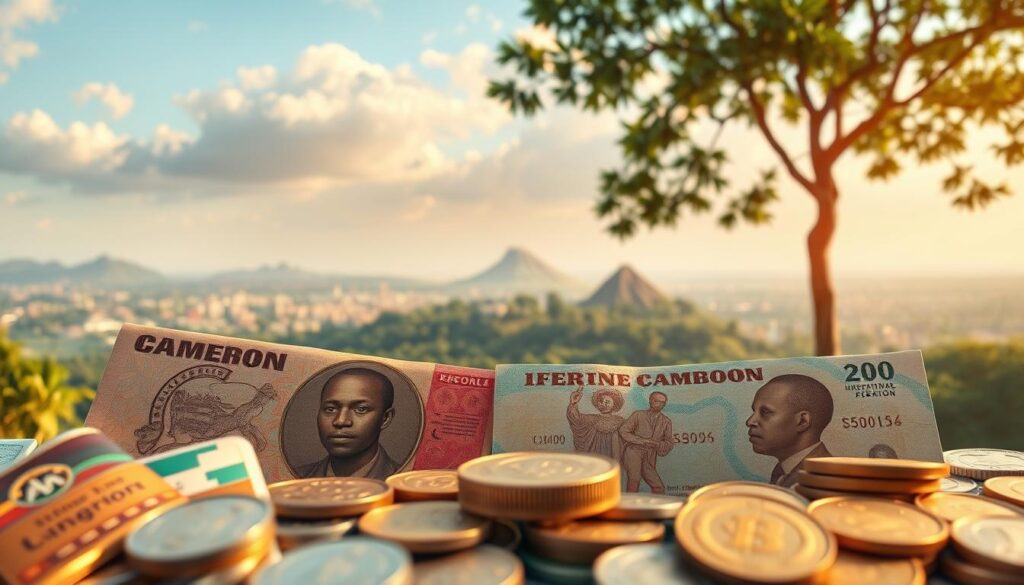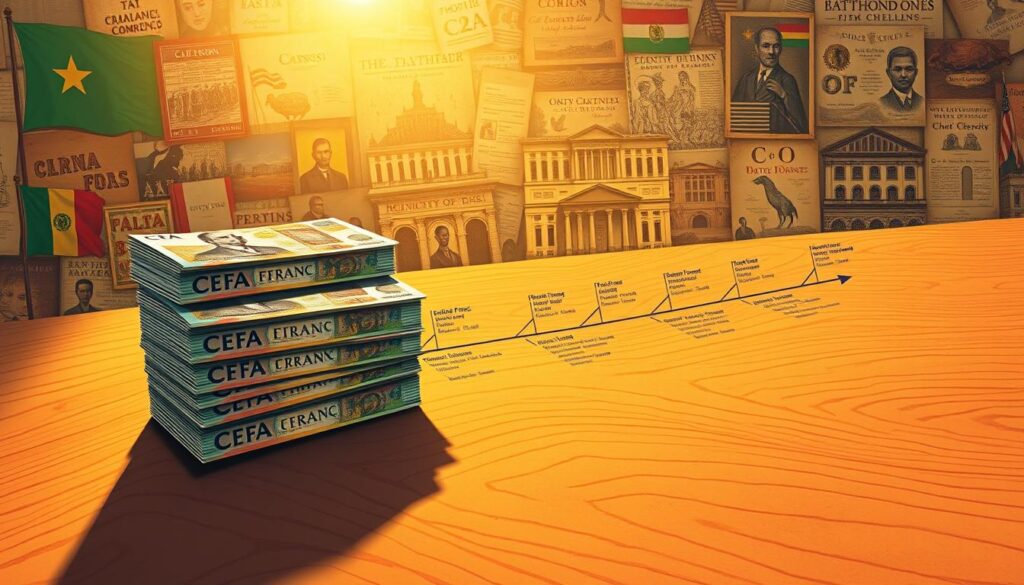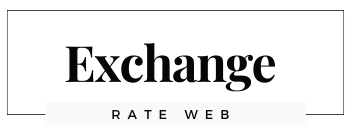
The story of Cameroon’s financial system is both complex and fascinating. It covers many eras, from before colonial times to after gaining independence.
Cameroon’s currency evolution has been influenced by key events and changes. These have shaped its economy over the years.
This journey has greatly impacted the country’s economy analysis. It also shows the wider historical context of the area.
Key Takeaways
- The history of Cameroon’s financial system is complex and multifaceted.
- Significant events have shaped the country’s currency evolution.
- Understanding Cameroon’s monetary history provides insights into its economy.
- The country’s financial system has evolved over multiple eras.
- Cameroon’s economy analysis is closely tied to its monetary history.
The Origins of Currency in Pre-Colonial Cameroon
The start of currency in pre-colonial Cameroon was based on traditional exchange systems and barter trade. Before modern money came, different groups in Cameroon used special ways to trade and do business.
Traditional Exchange Systems and Barter Trade
In pre-colonial Cameroon, barter trade was common. People traded goods and services without money. This system was based on giving back and finding something you needed.
They also used commodity-based currencies like salt, cloth, or animals. These items were valuable because they were useful or rare. They were used for trading, keeping track of value, and saving money.
Indigenous Currencies and Value Tokens
Indigenous currencies and tokens were key in pre-colonial Cameroon’s economy. Communities used brass rods, beads, and manillas (bracelets) as money. These items were not just for looks but also had value.
The use of indigenous currencies helped trade between areas and groups. It helped unite pre-colonial Cameroon economically. These currencies were linked to social and cultural values, making them complex in economic deals.
Colonial Monetary Influences (1884-1960)
The introduction of colonial currencies in Cameroon started a new economic era. This era was shaped by German, British, and French monetary systems. From 1884 to 1960, foreign currencies were imposed, greatly affecting the local economy.
German Colonial Currency (1884-1916)
The German Mark was the official currency during the German colonial period. The German administration brought a formal monetary system. This replaced traditional ways of trading and bartering.
The German Mark helped in integrating Cameroon into the global economy. It made trade and commerce easier.
British and French Monetary Systems (1916-1960)
After World War I, Cameroon was given to Britain and France by the League of Nations. The British Pound and the French Franc became the main currencies. These systems had a big impact on Cameroon’s economy.
The Impact of Colonial Currencies on Local Economy
The introduction of colonial currencies deeply affected Cameroon’s local economy. These new systems made trade easier but hurt traditional ways of trading.
The table below shows how colonial currencies impacted the local economy.
| Currency | Period | Impact |
|---|---|---|
| German Mark | 1884-1916 | Introduced formal monetary system, facilitated trade |
| British Pound | 1916-1960 | Influenced banking practices, introduced new financial instruments |
| French Franc | 1916-1960 | Integrated Cameroon into the Franc Zone, influenced monetary policy |
The legacy of colonial currencies still affects Cameroon’s monetary system. The country is still dealing with the effects of its colonial past.
Post-Independence Monetary Developments (1960-1972)
Cameroon gained independence in 1960, starting a new chapter in its monetary history. It introduced a national currency, a key step towards economic freedom. This move was crucial for developing a monetary system that met Cameroon’s unique needs.
Establishment of the First National Currency
The Cameroon national currency was a major milestone in the country’s economic journey. At first, Cameroon, like others, used the CFA Franc from the colonial days. But, Cameroon started working on its own currency to gain monetary independence.
Even though the CFA Franc was still used, this was the start of Cameroon’s path to its own currency.
A report noted, “The CFA Franc was a colonial legacy, offering some stability but limiting Cameroon’s monetary freedom.”
“The CFA Franc zone was created to provide a stable currency for former French colonies in Africa, but it also tied these countries to French monetary policy.”
Early Economic Challenges and Currency Stability
Cameroon faced big challenges in keeping its currency stable during this time. Switching to a new monetary system was tough. The country had to deal with inflation, exchange rates, and economic growth.
Keeping the currency stable was key for attracting investors, boosting trade, and driving economic growth.
- Economic diversification
- Monetary policy independence
- Currency management
The government took steps to tackle these issues. It set up monetary policies to fight inflation and keep the currency’s value strong. Experts said that currency stability was vital for Cameroon’s economic success.
The Birth and Evolution of the CFA Franc in Cameroon
The CFA franc’s introduction in Cameroon was a big change in the country’s money policy. It became the official currency, replacing old systems, thanks to the Franc Zone.

Introduction of the CFA Franc System
The CFA franc was created to help stabilize the economies of former French colonies. Cameroon, among these countries, chose the CFA franc as its currency. It was tied to the French franc and then the Euro. This move greatly affected Cameroon’s economy.
- Stabilization of the national currency
- Economic integration with other Franc Zone countries
- Monetary policy coordination with France
Cameroon’s Integration into the Franc Zone
Joining the Franc Zone through the CFA franc helped Cameroon work better with other countries. This move had both good and bad effects on Cameroon’s economy. It changed its money policy and trade with others.
- Increased trade with Franc Zone countries
- Loss of monetary sovereignty
- Dependence on French monetary policy
In conclusion, the CFA franc’s introduction in Cameroon was a key moment in its money history. It shaped its economy and its place in the world.
Cameroon Monetary History: Key Reforms and Policy Changes
Cameroon’s monetary history is filled with important reforms and policy changes. These have greatly shaped the country’s economy. They have played a key role in how Cameroon fits into the global financial scene.
Major Monetary Reforms (1972-1994)
From 1972 to 1994, Cameroon made big changes to its economy. These reforms aimed to stabilize the economy and boost the financial system. They were part of a larger plan to make the country’s economy stronger and more resilient.
One major part of these reforms was making the banking sector stronger. This was done through consolidation and better regulation. The period also saw efforts to improve how monetary policy was carried out. This made the financial system more efficient overall.
The 1994 CFA Franc Devaluation Crisis
The 1994 CFA franc devaluation crisis was a big event in Cameroon’s monetary history. It was a response to economic troubles in the Franc Zone, including Cameroon. The goal was to make exports cheaper and boost competitiveness.
The devaluation had both good and bad effects on Cameroon’s economy. It helped exports, especially in agriculture and mining. But it also made imports more expensive, leading to higher inflation and lower consumer spending power.
The government took steps to deal with these issues. They aimed to control inflation, help businesses hit by the devaluation, and keep the economy stable.
The Bank of Central African States (BEAC) and Cameroon
The Bank of Central African States (BEAC) has played a big role in Cameroon’s money policy. It is the central bank for the Central African Economic and Monetary Community (CEMAC). BEAC helps keep the financial system stable in the region.
Establishment and Functions
BEAC started in 1972 to manage money policy and keep finances stable for its members. These members are Cameroon, the Central African Republic, Chad, the Republic of Congo, Equatorial Guinea, and Gabon. Its main jobs include making and carrying out money policy, handling foreign exchange, and watching over banks.
BEAC’s money policy framework aims to keep prices stable and help the economy grow. It uses tools like setting interest rates and controlling money supply to do this.
Cameroon’s Role in Regional Central Banking
Cameroon is important in regional banking because it’s part of CEMAC and a BEAC shareholder. The country helps make decisions that affect the whole region through BEAC.
Cameroon’s economic influence in CEMAC is big. It helps shape money policies for the region. Cameroon’s role in BEAC shows its dedication to working together on money matters.
The BEAC governor said, “The stability of the financial system is our top priority.” This focus on stability is key for Cameroon’s growth and its role in the regional economy.
Economic Crises and Monetary Policy Responses
Cameroon’s economic history is filled with crises, like the 1980s oil crisis and the 2008 global financial crisis. These events deeply affected its monetary policies. They tested the country’s economic strength and led to big changes in its money management.
The 1980s Oil Crisis and Monetary Implications
The 1980s oil crisis hit Cameroon hard because it relies a lot on oil exports. When oil prices fell, Cameroon’s income dropped. As Alain Desrosières said, “The oil crisis was a big change for economic policies in oil-exporting countries, including Cameroon.”
Structural Adjustment Programs and Currency Effects
Cameroon faced economic hard times after the oil crisis. It started Structural Adjustment Programs (SAPs) to fix its economy. These programs aimed to make the economy stable and competitive.
As part of SAPs, Cameroon made big changes, like devaluing its currency, the CFA Franc.
“The devaluation of the CFA Franc was a critical step in adjusting Cameroon’s economy to the realities of the global market.”
The 2008 Global Financial Crisis Impact
The 2008 global financial crisis also hit Cameroon hard. It affected global trade and prices of goods. This led to less foreign investment and lower demand for Cameroon’s exports.
The Bank of Central African States (BEAC) worked to keep the financial system stable.
In conclusion, Cameroon learned a lot from its economic crises. These lessons have shaped its economic policies and prepared it for future challenges.
Inflation Patterns and Exchange Rate Dynamics
Cameroon’s economy has seen big changes due to inflation and exchange rates. Its money history is a mix of inside and outside factors. These have shaped its economic plans.

Historical Inflation Trends in Cameroon
Cameroon has seen different inflation trends over time. These have been influenced by economic policies, global prices, and regional money plans. The country’s inflation rate has stayed steady lately, thanks to smart money policies by the Bank of Central African States (BEAC).
Key factors influencing inflation in Cameroon include:
- Monetary policy decisions
- Global economic trends
- Domestic supply and demand dynamics
A financial expert said, “The stability of Cameroon’s inflation rate shows the success of its money policies. These policies have kept the economy stable.“
CFA Franc Exchange Rate Mechanisms
The CFA franc, used by Cameroon and others, is tied to the Euro. This keeps the exchange rate steady. But, it also has good and bad sides, affecting trade and competitiveness.
The BEAC manages the CFA franc’s rate against the Euro. This keeps the currency stable. A report said, “
The CFA franc’s tie to the Euro has brought stability but also challenges for Cameroon’s exports.
“
Understanding inflation and exchange rates is key to seeing how Cameroon’s economy is doing. It helps predict what might happen in the future.
Modern Financial System and Digital Currency Developments
Cameroon’s financial scene has changed a lot in recent years. This change comes from better banking and digital payments. These updates have made the financial system stronger and more open, helping more people.
Banking Sector Evolution
The banking world in Cameroon has grown a lot. Commercial banks now offer more services to people and businesses. They also work hard to teach everyone about money and how to use it.
Mobile Money and Digital Payment Innovations
Mobile money has changed how people in Cameroon send money. It’s easy and safe. Digital payments have also made it easier for people and businesses to deal with money.
More people have phones and internet now. This means more people can use financial services. It helps the economy grow.
Regional Monetary Integration and Future Prospects
Cameroon’s path towards regional monetary integration is filled with both hurdles and chances. As a part of the Economic and Monetary Community of Central Africa (CEMAC), Cameroon works towards a common goal. This goal is to boost monetary cooperation and stability across the region.
CEMAC Monetary Cooperation
At the heart of CEMAC’s efforts is the use of a shared currency, the Central African CFA franc. The Bank of Central African States (BEAC) oversees this. This setup makes trade and investment smoother among member states by cutting down on currency exchange costs.
Key aspects of CEMAC monetary cooperation include:
- Common monetary policy
- Shared currency
- Regional central banking
| Aspect | Description | Benefit |
|---|---|---|
| Common Monetary Policy | Unified monetary policy for all CEMAC member states | Economic stability |
| Shared Currency | Use of Central African CFA franc | Simplified trade |
| Regional Central Banking | Bank of Central African States (BEAC) manages monetary policy | Financial stability |
Challenges and Opportunities for Cameroon’s Monetary Future
CEMAC’s monetary cooperation brings many benefits, but there are also challenges. These include the need for more economic diversification, better financial inclusion, and more effective monetary policies.
Cameroon can use its role in CEMAC to draw in investments, boost trade, and spur economic growth. By tackling these challenges and seizing the opportunities, Cameroon can improve its monetary future. This will help stabilize the regional economy.
Conclusion: Lessons from Cameroon’s Monetary Journey
Cameroon’s monetary history offers important lessons for its economic growth. The shift from traditional to digital currencies has seen major steps. These include the use of colonial currencies, the CFA Franc, and the growth of the banking sector.
Looking at Cameroon’s monetary past teaches us a lot. It shows how colonial currencies affected the economy. It also points out the hurdles of monetary policy and the value of regional money ties.
Understanding Cameroon’s monetary path is key for its economic analysis. By studying its history, leaders can spot areas to improve. This helps in creating a stable and growing economy.
The lessons from Cameroon’s past stress the need for ongoing reforms and cooperation. Moving forward, the country must use its progress wisely. It must tackle future challenges to ensure a strong and prosperous economy.
FAQ
What was the primary currency used in pre-colonial Cameroon?
Before colonial times, Cameroon used different ways to trade. People exchanged goods like cowry shells, iron rods, and other items.
How did colonial powers influence Cameroon’s monetary system?
The German, British, and French colonizers brought their own money to Cameroon. This changed the local economy a lot.
What is the CFA franc, and how did it come into use in Cameroon?
The CFA franc is a currency used in Cameroon and other Central African countries. France introduced it as part of the Franc Zone. It has been used in Cameroon since it gained independence.
What role does the Bank of Central African States (BEAC) play in Cameroon’s economy?
The BEAC is the central bank for the Central African Economic and Monetary Community (CEMAC). It manages the CFA franc and helps with regional money cooperation.
How has Cameroon’s economy been affected by global economic crises?
Cameroon has faced many economic challenges. These include the 1980s oil crisis, structural adjustment programs, and the 2008 global financial crisis. These have greatly affected the country’s economy and money policies.
What are the main challenges facing Cameroon’s monetary future?
Cameroon’s future money challenges include regional money integration, keeping the currency stable, and diversifying the economy. It also needs to adapt to global economic changes.
How has the banking sector in Cameroon evolved over time?
Cameroon’s banking sector has changed a lot. New financial tools, more banking services, and digital payments have been introduced.
What is the significance of the CFA franc devaluation crisis in 1994?
The 1994 CFA franc devaluation crisis was a big event for Cameroon. It led to a big drop in the currency’s value. This had a big impact on the country’s economy.
How does Cameroon’s monetary system relate to regional economic integration efforts?
Cameroon is part of the CEMAC. This group aims to improve economic ties and cooperation among its members. This includes working together on money matters.
What are the implications of Cameroon’s monetary history for its economic future?
Knowing Cameroon’s money history helps us understand its economic growth and challenges. It shows the need for ongoing economic reforms and changes in money policies.

Adam G
This post was created by Adam G, a seasoned financial writer with a passion for explaining currency exchange and market movements
